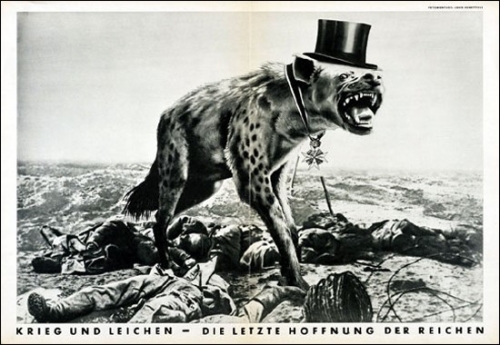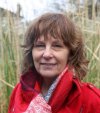John Heartfield: satirist, anti-fascist and fearless communist

Jenny Farrell salutes John Heartfield, the creator of political photomontage, who died fifty years ago.
John Heartfield is one of the most important European artists. He works in a field which he created himself, the field of photomontage. Through this new form of art, he exercises social criticism. Steadfastly on the side of the working class, he unmasked the forces of the Weimar Republic driving towards war; driven into exile he fought against Hitler. The works of this great satirist, which mainly appeared in the workers’ press, are regarded as classics by many, including the author of these lines. - Bertolt Brecht
John Heartfield died fifty years ago, on 26 April 1968. He is the founder of political photomontage and a fearless communist and activist, who lived through two world wars.
Helmut Herzfeld was born on 19 June 1891 in Berlin. His parents abandoned Herzfeld, his brother and two sisters, at a very young age, in 1899. The children lived with relatives after that. After finishing school in 1905, the brothers moved first to Wiesbaden, and from there to Munich, in 1909, where Heartfield studied art. Initially, he worked as a commercial artist and later continued his studies in Berlin. In protest against chauvinist war propaganda and the greeting “May God Punish England”, Herzfeld translated his surname into English, calling himself John Heartfield thenceforth.
Heartfield’s brother Wieland and he worked closely together throughout their lives. Together they published the magazine “Neue Jugend” in Berlin in 1917-18, where John Heartfield pioneered a new typography. They founded the Malik-Verlag publishing house in 1917. When the Communist Party of Germany was founded, at the end of December 1918, Heartfield joined immediately. He produced stage sets for proletarian theatres, posters for the Communist Party, and contributed artwork for magazines and pamphlets.
Over the following years, he began experimenting with new ways of working with photographs. These photomontages were used for the book covers of the Malik-Verlag and other progressive publishing houses. Heartfield also collaborated with other anti-fascist artists, such as George Grosz, especially in creating collages in the early post-war years.

Fathers and Sons, 1924
Photomontage became Heartfield’s specific artistic weapon. He made photomontages commenting on contemporary politics, starting with the famous image “Fathers and Sons” in 1924. After 1930, he contributed frequently to the weeklies “Arbeiter-Illustrierte-Zeitung” (AIZ) and “Volks-Illustrierte” (VI), often collaborating with Wieland in creating montages. Heartfield’s photomontages on the covers of the widely sold AIZ, appeared at newsstands across Germany. He used Rotogravure, engraving pictures, words and designs, into the printing plate, to design montages on posters, which were distributed in the streets of Berlin in 1932 and 1933.
The spirit of class struggle and in particular of the October Revolution imbues the book covers he created for the works of revolutionary German, American, and Soviet writers, for the collected editions of Tolstoy, Gorky, Ehrenburg and Sinclair. He responded directly to world events: the British general strike in 1926; the execution of Sacco and Vanzetti in 1927; the planned frame-up of the eight Scottsboro boys in Alabama, USA, in 1931.

This is the God they they bring, 1938
When fascism took over in Germany, the Nazis targeted him immediately. A dramatic flight brought him to Prague, where he resumed his work for the emigrated AIZ and the Malik-Verlag. An entire series of photomontages was dedicated to the trial of Dimitrov in 1933, later, in 1936-37, to the battles of the Spanish Republic and the International Brigades.

The meaning of the Hitler salute, 1932
In 1938, Hitler demanded the extradition of Heartfield and other anti-fascists. This demand was rejected by the Czechoslovak government. He fled to London shortly before the Nazis marched into Prague in December 1938, where he was initially interned as an enemy alien. Following his release, he received permission to stay in Britain, whilst Wieland did not and had to flee to the United States. In London, Heartfield co-founded the active “Free German League of Culture” and earned his living as typographer and designer for British publishing houses.
Returning from Britain in 1950, he settled in the German Democratic Republic, initially in Leipzig and then in Berlin. Despite serious heart trouble, he continued working, creating stage settings and theatre posters for the Deutsches Theater in Berlin, and for the Berliner Ensemble, as well as political posters for the state.
John Heartfield wrote the following passage for the catalogue of the last two exhibitions held during his lifetime:
Since we are living in the nuclear age a Third World War would mean a catastrophe for the whole of humanity, a catastrophe the full extent of which eludes our imagination. Before the outbreak of the Second World War, on 13 October 1937, I made a photomontage entitled Warning. A cinema audience was shown watching scenes of horror caused by a Japanese air raid on Manchuria in the Far East. The caption read: 'today you will see a film from other lands. But know that if you do not resist unitedly today, it will kill you tomorrow.’ The campaign of extermination against the Vietnamese people, fighting heroically for their existence, caused me to change the first line of the caption. Now it reads: '... You will see a film from far-off Vietnam.’
“Now the war has reached the Near East. A short while earlier the monarcho-fascist putsch in Greece smothered every democratic political movement. The fire is at the gates!
“Today the people of peace of all countries must work together even more closely, and mobilise all resources to strengthen and save world peace, since warlike rulers are rallying for war. The Civil War in Spain was the fascist manoeuvre field for the Second World War; in the same way today’s wars endanger world peace.
“With his famous painting ‘Guernica’ Picasso supported the heroic anti-fascist writers in Spain. He succeeded his compatriot Goya in the struggle against war. He also created the wonderful lithograph of the world-famous flying dove of peace. That the dove shall never again be impaled upon a bayonet (as shown in one of my photomontages), all advocates of peace, whatever their political opinions, must close the ranks in the fight to maintain peace.
My brother Wieland Herzfelde, my trusted helper and co-combatant against exploitation and war, wrote a poem entitled ‘The Soldiers of Peace’. It begins with these words:
We are the soldiers of peace.
No nation
And no race is our enemy
And it ends:
Peoples, may your children
All be saved from war.
Preventing war
Shall be your triumph.
And to work for this great triumph has been the aim of his and my artistic work since our earliest youth.” - Berlin, 9 June 1967.


Jenny Farrell
Jenny Farrell is a lecturer, writer and an Associate Editor of Culture Matters.
Latest from Jenny Farrell
- Poetry for the Many, an anthology by Jeremy Corbyn and Len McCluskey
- A hopeful vision of human renewal: the theatre of Seán O'Casey
- Art that's rooted in the upheavals of his time: Caspar David Friedrich, 1774-1840
- A Drive to Change the World: James Baldwin, Black Author, Socialist and Activist
- A woman's perspective on the invisible front: A review of 'The Shadow in the Shadow'
